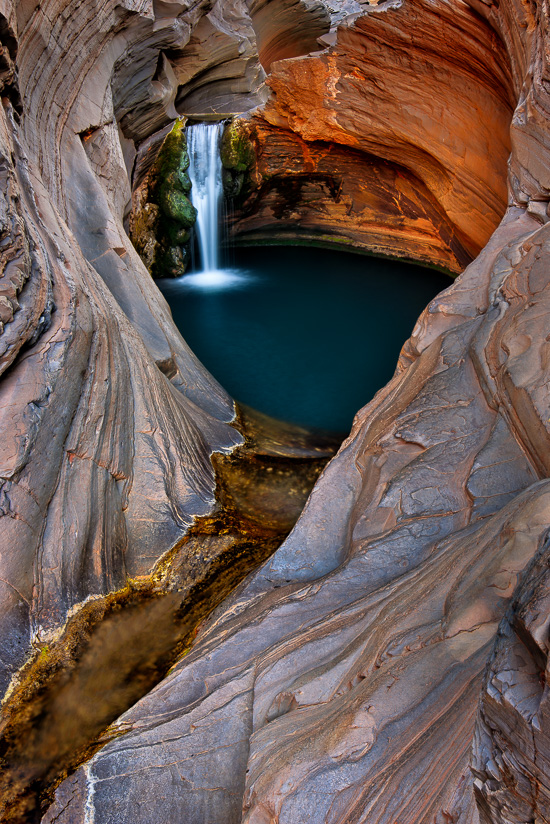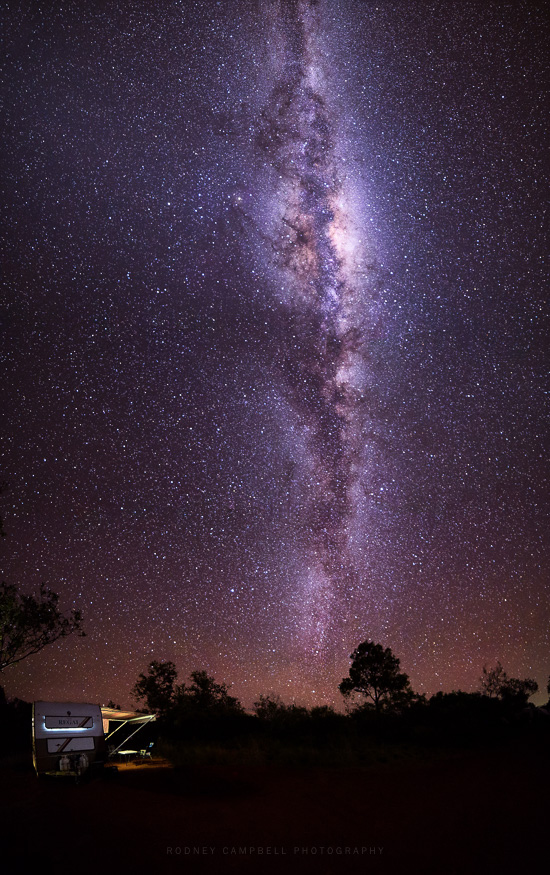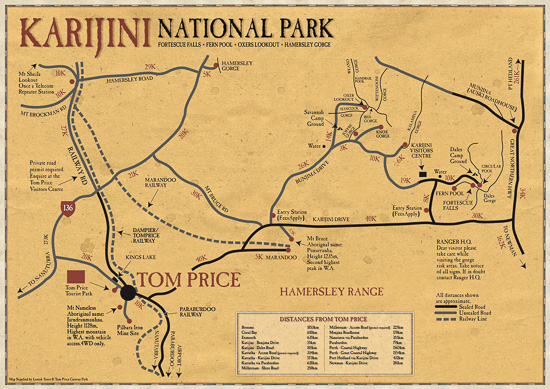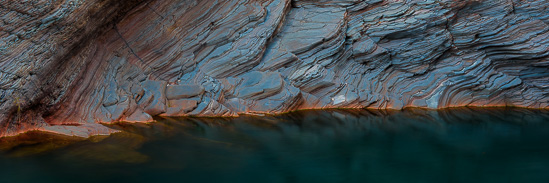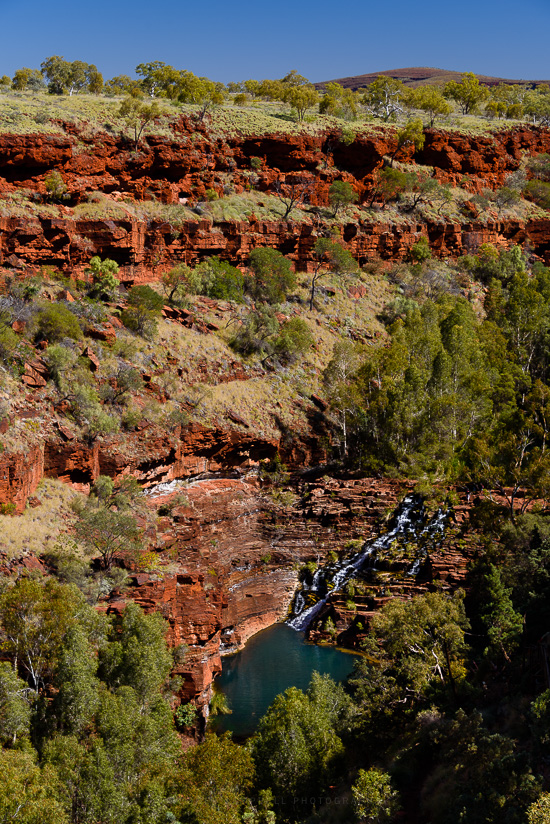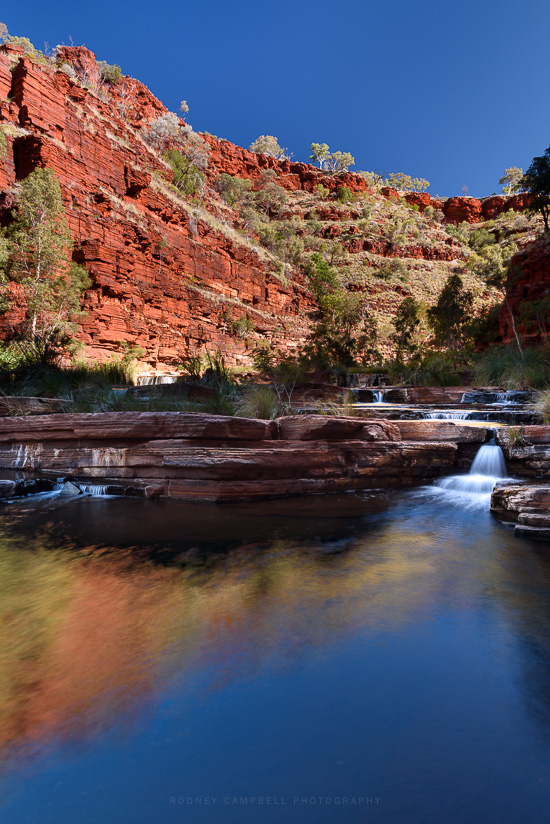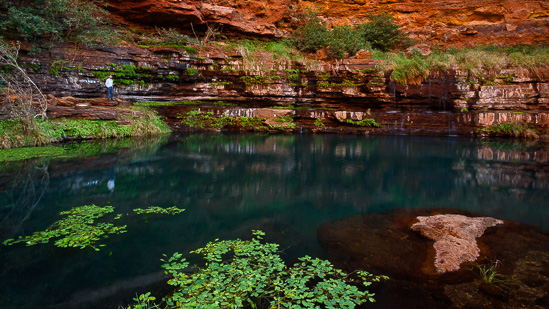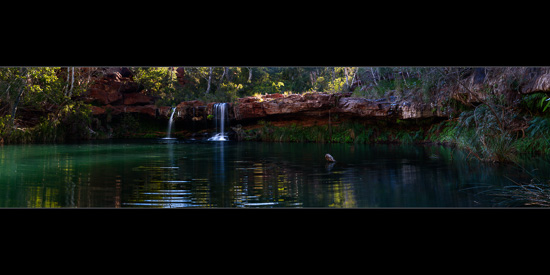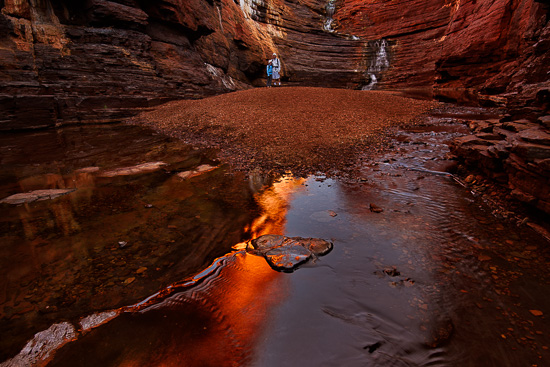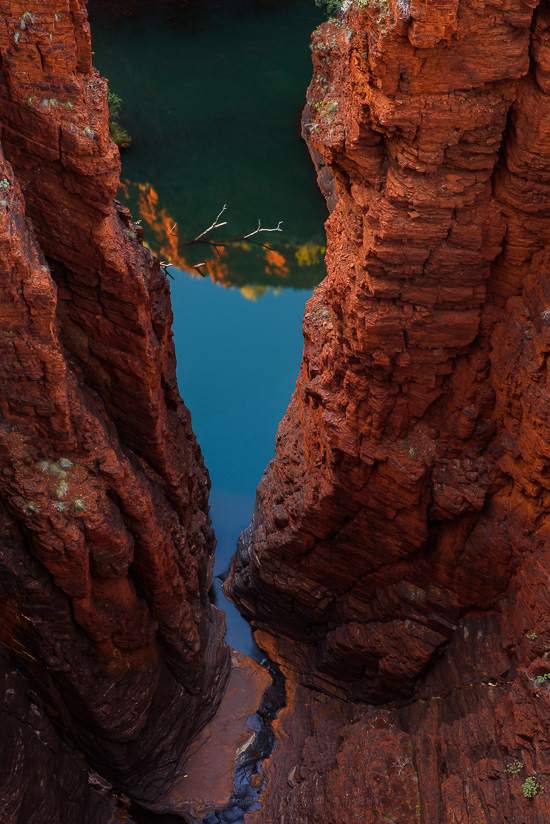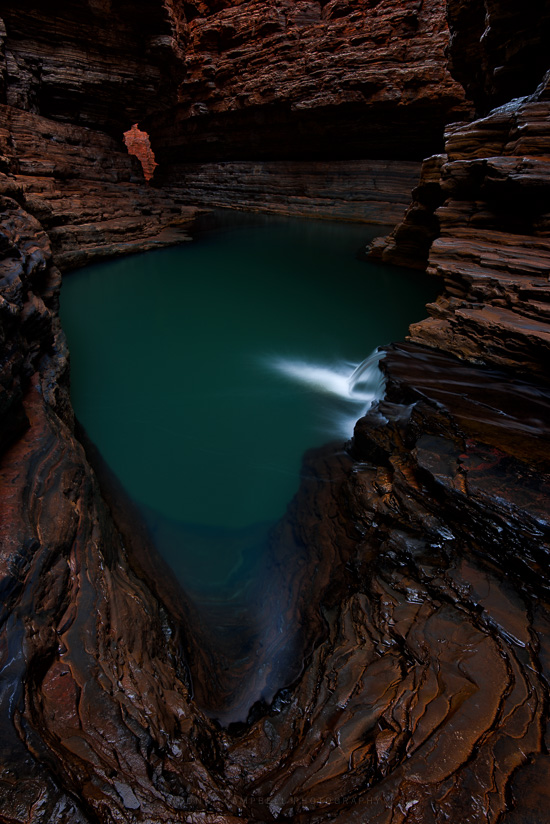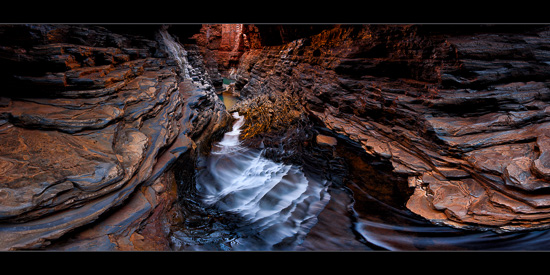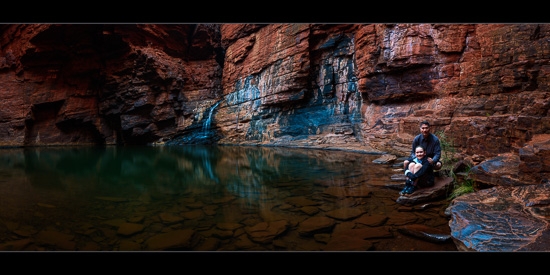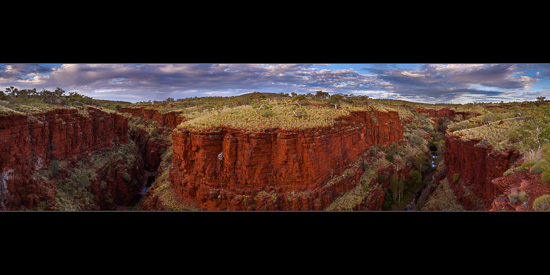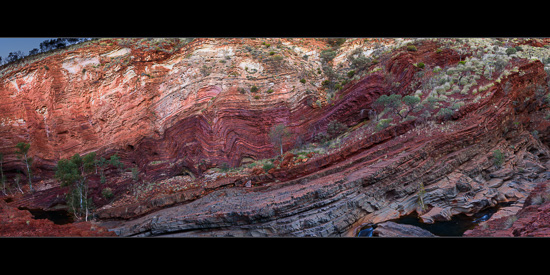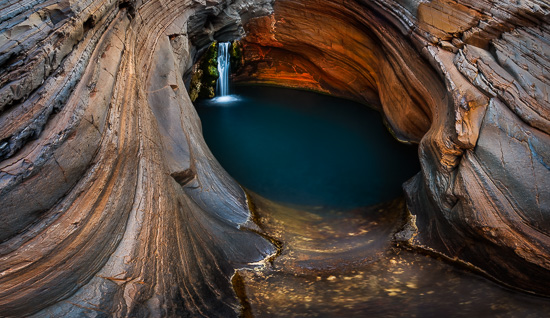Karijini Guide for Visitors & Photographers…
by Rodney Campbell on Apr.01, 2016, under Life, Photography
Karijini Guide for Visitors & Photographers
I did quite a bit of research before I went to Karijini (I wanted to be adequately prepared). I also spoke to a number of people who had been there and collated my own notes before travelling there. Here I present my Karijini Guide for Visitors & Photographers which is based on the information I gathered beforehand and updated based on my own experiences there. I hope if you do plan to go there (and if you are a photographer and even if you aren’t – I highly recommend it), that you find this useful.
The Spa Pool
Karijini National Park is one of the largest and most photogenic national parks in Australia. Covering 627,422 hectares just north of the Tropic of Capricorn in the Hamersley Range, Karijini is Western Australia’s second largest park. Massive mountains and escarpments rise out of the flat valleys. The high plateau is dissected by breathtaking gorges, and stony, tree-lined watercourses wind their way over the dusty plain. The park is famous for its sheer gorges, waterfalls, sparkling rock pools and cool swimming holes. The park is all about exploring serpentine tunnels of marbled rock, clambering over boulders, squeezing through narrow tunnels, inching your way along ledges, paddling through subterranean waterways and descending deep into chasms which have been eroded into the landscape over two billion years.
Where to Stay
There are really only two places to stay within Karijini National Park.
Dales Gorge Camping Ground is at the eastern end of Karijini and close to delights such as Dales Gorge, Fortescue Lookout, Fortescue Falls, Fern Pool and Circular Pool. The Karijini Visitors Centre is also at this side of the park.
It is quite cheap to stay in an unpowered campsite at Dales Campground and the new shared amenities (toilets) are very good. There are no showers however and no drinkable water onsite (it’s about a 10km drive to the water tank). $10 adult per night, $6.60 concession card holder per night, $2.20 child per night (over 5 and under 16 years).
Sleeping Under the Stars
Karijini Eco Retreat (formerly Savannah Campground) also has unpowered campsites with shared toilets and (solar) showers and an outdoor kitchen with drinking water. There’s also a range of other accommodation at the retreat from upmarket tents to cabins. There is also a restaurant and some other amenities.
It’s relatively expensive to stay here (even for a bare campsite) however you essentially have no other choice if you plan to stay at this end of the park. e.g. Unpowered Campsites are $20 per day per person.
The Eco Retreat is however right next to Joffre Gorge & Joffre Falls and is a short drive from many other gorges and spectacular features including Hancock Gorge, Spider Walk, Kermits Pool, Regans Pool, Weano Gorge, Handrail Pool, Oxer Lookout, Junction Pool Lookout and Knox Gorge.
Travelling Around
You will need a vehicle to travel to most of the gorges. You can easily walk from the Eco Retreat to Joffre Gorge and if you are staying at Dales you can walk to the Fortescue Falls lookout, Circular Pool is a bit further away but would be doable. Everything else you basically have to drive to. From the Eco retreat it is about a 15min drive to most of the nearby gorges (like Hancock, Weano, Knox).
Most of the roads around all the gorges are dirt and some are very rough.
Karijini National Park
Contrary to what most of the maps might say it is now a nice sealed road all the way from outside the park to the Karijini Visitor centre at the eastern end and also almost to the Dales Campground. Likewise Bunjima Drive at the western end is now a nice sealed road almost to the Eco Retreat (the sealed road stops about 3km away). However the roads from the Eco Retreat to all the nearby gorges are all mostly dirt.
There is a road that goes between the Eco Retreat and the Visitors Centre/Dales end however it is sometimes so bad it is impassable (when we were there even 4WD’s broke down and lost their axle on the road it was so rough). You can however take the “long” way around by following the sealed roads back outside the park and travelling along Karijini Drive between the sides. It’s an 80-90km drive the long way but on sealed roads it may well be faster than the more direct dirt road anyway.
There is one major gorge that is a long way from both campsites. Hamersley Range, Hamersley Gorge and it’s famous Spa Pool is a 90+min drive from the Eco Retreat (the majority on dirt roads). It’s actually closer and quicker to get there and back from the major “city” of Tom Price so if you are staying there it would be an option to go from there. Note that Tom Price is about an hours drive from the Eco Retreat and the gorges near there.
Flowing Away
Some General Tips
Best Times to Visit:
The best times to photograph – skip that – the best times to be in the gorges even as a visitor is either early morning (from a bit after sunrise till about three hours after sunrise) or late afternoon (from three hours before sunset till sunset).
There are a number of reasons why this is the case:
– firstly in the morning case – you will likely be the only person down there. In all of the gorges I went into early in the morning I had the whole gorge and the best locations to myself. It wasn’t till I was just about to leave that the first of the many tourists started to arrive
– secondly at these times you escape the oppressive heat of the day. It’s hot in this part of the country – I was there in winter and it was still insanely hot
– for photography the best light is when the gorges have this delicious low side light which reflects off the upper walls and spills softly down into the depths below. Once the sun creeps high into the sky the harsh unfiltered sun hits those walls like a hammer taking away the richness of the colour and depth of the texture. You definitely don’t want the sun beaming straight down into the bottom of the gorge
– for most morning shoots I like to arrive on location about an hour before sunrise however there’s no point going down into the gorges before sunrise – it’s just too dark. You can however shoot from the lookouts at the top of many gorges (Dales, Oxer, Knox, etc) especially if you are lucky enough to get some nice colour or clouds.
What to Wear:
It’s actually a lot cooler down at the bottom of the gorges but unless you go swimming it’s not so cool that you can’t just wear a T-shirt and shorts if you desire. I’d actually suggest you wear shorts (there really isn’t that much brush you have to walk past that might scratch your legs) because your legs may get wet. It’s probably not that comfortable walking around in wet jeans. For me I wore a light long sleeve shirt most of the time. It was pleasant enough early in the morning and late in the afternoon/evening to warrant it and it also protected me more from the sun. The ones I purchased for this trip were very light, quick dry, cool to wear, high SPF and had ventilation in the back as well as being impregnated with some sort of bug repellant.
For the same reason I’d also suggest wearing shoes that you’re happy to get completely wet. For both my daughter and I we packed “water shoes” for this specific reason. Think runners that are designed to go in water, walk over wet rocks and have good grip on the soles.
Here’s the thing – you “probably” can make your way through most sections of most of the gorges without having to get wet. You would have to in some places really work at scrambling up and around the edges of the gorges to get around some semi flooded areas. Some of these areas however have very steep and slippery sides you’d have to navigate. You could do that, spend a whole lot of time and risk slipping and falling or you could just walk through the water at these places quickly and easily. It saves you lots of precious time that could be better spent taking photographs in these once in a lifetime places. When we were there I think the deepest my daughter and I had to wade was perhaps at my waist (excepting one specific location – which I’ll get to).
What to Bring:
Here is another one of those technically you don’t need it things (again excepting a specific place).
One of the items I invested in and brought with me was a Dry Bag – in my case I got this backpack version from Overboard. This enabled me to put all my gear in the bag (Camera, Lenses, filters, remote, spare clothes, food, etc) and have my water bottle and tripod on the outsides. It’s not absolutely necessary to have a dry bag for most of the gorges (even Hancock). What it does let you do however is not worry about your gear getting wet so you can happily wade through sections of the gorge which is much much quicker than trying to carefully inch your way around the sides worrying that you might drop your gear into the water. Frankly with limited time down there I’d rather spend twice as much time shooting.
There is one specific spot however where it would be mandatory. In Weano gorge the end of the “normal” walk in is the Handrail Pool. Something I didn’t know before going is you can make it to the Handrail pool and down the handrail and just under half way around the pool at the bottom by skirting around the sides without having to swim. However that is normally as far as you can go.
You can however swim across the last of the Handrail pool to a cut and a further gorge on the other side of the pool from the handrail. This gorge extends another 100m further on and in some parts you HAVE to swim (you can’t even wade – it’s deeper than I was tall and the sides are cliffs of slick rocks). After going through a bit of an underground tunnel you come to a spot where there is a dropoff where you cannot go any further (without ropes, guides, etc) however you can shoot down the dropoff to the pools below and the gorge extending beyond.
If you want to take your camera here you have to have a dry bag.
If you plan to swim you may want to factor in that the water is freezing – I mean take your breath away cold. Before heading there I was considering buying some sort of light wetsuit/sharkskin thing to wear for this single bit. In the end I didn’t and I figured I’d risk it and just take a towel and something warm to wear afterwards (a thermal top). I’m glad I did because I was shivering to death by the time I got back to the Handrail pool :).
How Far/Long/Hard is the Walk:
Most of the Karijini Guides for walking (e.g. Karijini National Park information and Walk Trail Guide, Karijini National Park – Dales Recreation Area map and walk trail guide – Circular Pool, Dales Gorge, Fern Pool, Fortescue Falls , Karijini National Park -Weano Recreation Area map and walk trail guide – Hancock and Weano gorges, Junction Pool, Oxer lookout) will give you estimates for distances and times for return trips in the various gorges.
I found the stated times to be in my case an over-estimate in most cases. e.g. 2 hours return to Kermits Pool or a number of hours return from the Spa Pool. If you are reasonably fit and competent over rough and uneven ground you can get there in much less than half this time. e.g. Kermits pool is easily reachable in under 30 minutes.
The actual distances you travel waling in most of the gorges is also surprisingly short (much shorter than I had envisaged). Possibly the only gorge walk that lived up to both the distance and time expectation was the walk from the Three Ways Lookout at Dales gorge down to the bottom and then along the length of Dales Gorge to Fortescue Falls and Fern Pool beyond.
The guides also rate the difficulty of the walks from Class 2 to Class 5.
Class 2 – These walks are well defined with some steps and generally gradients are gentle.
Class 3 – These trails are defined and may include steps; loose surfaces; uneven ground; and short, steep sections.
Class 4 – These trails are moderately difficult and over variable surfaces – they require a good level of fitness. Expect steep gradients and natural obstacles including rocks and shallow pools.
Class 5 – These trails are difficult and a high level of fitness is required. Trail markings are minimal, and steep sections with vertical
drops are common. Expect to encounter natural hazards including large boulders; pools of water; slippery, wet rocks; and narrow, high ledges.
There are also some Class 6 areas but these require ropes, abseiling/climbing gear and guides to go to.
To get to most of the places you probably want to go you’ll encounter Class 4 and Class 5 trails.
To give you an idea however my 10 year old daughter was easily capable of joining me on some Class 5 gorges so I expect most people should be able to manage them all.
Note: I personally believe from a “danger of serious injury” point of view that the climb to get to the bottom of Joffre gorge is actually the most exposed and worst of the lot (and my daughter did that).
Other Things You Should Know:
There is no mobile coverage basically anywhere in the park (not even where the accomodation is) – so you have no cover in any of the gorges. There is some coverage near Karijini Drive and anywhere near Tom Price. Interestingly there is also some coverage at the top carpark at Hamersley Gorge (but not at the bottom car park or in the gorge).
There is (paid) WiFi at the Eco Retreat and there’s actually free WiFi at the Welcome Rest Stop at the top carpark at Hamersley.
If there is an emergency there are some fixed emergency radios in boxes on poles at the top of some of the gorges.
What Would be My Top Picks:
If I was time limited and had to choose I’d say my first picks would be Hancock Gorge or Weano Gorge. My next pick would be Hamersley Gorge (it’s very different to Hancock or Weano but it’s a long way there and back).
Notes for Specific Gorges
In addition to the information you can find in the WA Parks and Wildlife guides I linked to for Karijini here are some extra specifics you may find useful.
Eastern End:
Top of the gorge at sunset look across to the far side with it’s trees and low hills. Contrast blues of sky, greens of trees, yellows of spinifex against rich red of gorge itself. Either at Three Ways Lookout or Fortescue Falls Lookout. Also works later well after sunrise.
Fortescue Falls
Most of the trails down and along the bottom of the gorge are Class 4.
Gorgeous
This would be best in the early morning.
Circular pool and the walk there is pretty average and then it’s a huge hike to the other end for Fortescue Falls and the Fern Pool if you decide to do it all in one go. If you had limited time you could skip most of it and just go to the Fortesque Falls/Fern Pool end from the Fortescue Falls lookout rather than tackling the very steep steps at the Three Ways Lookout and the long walk along the bottom of the gorge (which is beautiful no doubt, but it is a long walk).
Emerald Waters
Probably best in the late afternoon.
Probably best in the early morning (although I shot it late afternoon).
Fern Pool isn’t marked on quite a few maps, it is sacred to the local indigenous people who actually “own” Karijini, it needs to be treated with respect as any other sacred place would be. It is a very nice (cold) swim there.
Fern Pool
Western End:
Joffre Gorge should be fine early morning or late afternoon.
Joffre Falls is probably best late afternoon/sunset.
River of Gold
Most of the trail is Class 4, but the last 150 metres (descent into the bottom of the gorge) is Class 5.
Oxer Lookout and Junction Pool Lookout:
The guide says these are a 30 min return trip from the carpark. There’s actually a car park further past the main carpark at the Weano Recreation Area which is right next to the lookouts for a quick couple minute walk.
These work as a pre-sunrise and sunrise spot for sure.
Junction Pool Lookout offers spectacular views down to Junction Pool, 100 metres below.
Junction Pool Lookout
Continuing on from this lookout about 50m gets you to Oxer Lookout, which provies visitors with a view of the junction of Weano, Red, Hancock and Joffre gorges. Here, tiers of banded rock tower over deep pools at the bottom. The track to the lookout is not universally accessible. Immediately to the north of the lookout is Weano Gorge, with Red Gorge more or less straight ahead, but slightly to the east. Joffre Gorge lies to the south of Red Gorge, and Hancock Gorge is on the south side.
Both lookouts are metal platforms sticking out over the cliffs so you do have to be careful with vibrations moving your tripods and cameras. I used a wireless remote which I triggered either once I stepped off the platform or was standing very still. Obviously if there are other people around you have problems.
This gorge would suit an early to mid morning. Notable locations in Hancock Gorge include the Spider Walk and Kermits Pool.
At the top an easy Class 2 trail leads you to the edge of the gorge where there’s a ladder to descend to the bottom. From here onwards it is Class 5.
Getting in to Kermits requires a little wading though not too deep.
The theory with the spider walk is you walk along with your arms and legs spayed to the sides and creep along with the water running below you. Personally I found it much quicker and easier to just walk along the bottom being careful not to slip.
Kermits Pool
Just after Kermits pool there is a chain across the gorge with signs warning you not to go any further. About five metres past the chain however is an excellent view down the gorge towards Regans Pool. Do NOT attempt to go down there however (without ropes and guides) – people have died.
Regans Curve
This spot also suits an early to mid morning. Notable locations in Weano Gorge include the Handrail Pool and a dropoff 100m (swimming in extremely cold water) past the pool. There is also a very nice little circular pool just before the handrail.
Getting in requires a little wading though not too deep – probably not above the waist.
Holding Echoes
To get inside the cavern where the Handrail pool resides you have to use a curved metal handrail to climb down from where the gorge emerges above the pool. It’s a relatively easy descent with steps carved into (or bolted onto) the rock. At the bottom you can work your way just under halfway around the side of the pool at the bottom.
Two Class 4 walking track options from the Weano Day Use Area lead you down into the bottom of Weano gorge. The last part before you get to the handrail is Class 5.
An excellent sunset location especially if you’re lucky enough to get some nice clouds.
From the car park it is a short 5-10 min Class 2 walk to Knox Gorge Lookout.
Knox Bend
I didn’t get the chance to walk down into Knox Gorge. I have heard it is quite a strenuous journey.
Hamersley Gorge & The Spa Pool:
Hammersley Gorge & the Spa Pool are best in very late afternoon to sunset. This gorge is very different to the more slot canyon type gorges elsewhere. It’s a lot wider and more open to the sky. I’d recommend very late, the contrast and sunlight is incredibly harsh otherwise – best to arrive mid to late afternoon, have your swim, then do photos.
Hamersley Folds
The Spa Pool is only a 10-15min walk from the car park. It’s a Class 3 trip down to the bottom then Class 4 along the bottom of the gorge. There is one also particularly tricky spot about half way along the bottom to the Spa Pool.
Hamersley Spa
Being so far away from anywhere also means the long drive back will be at night so will be slower than the trip there.
